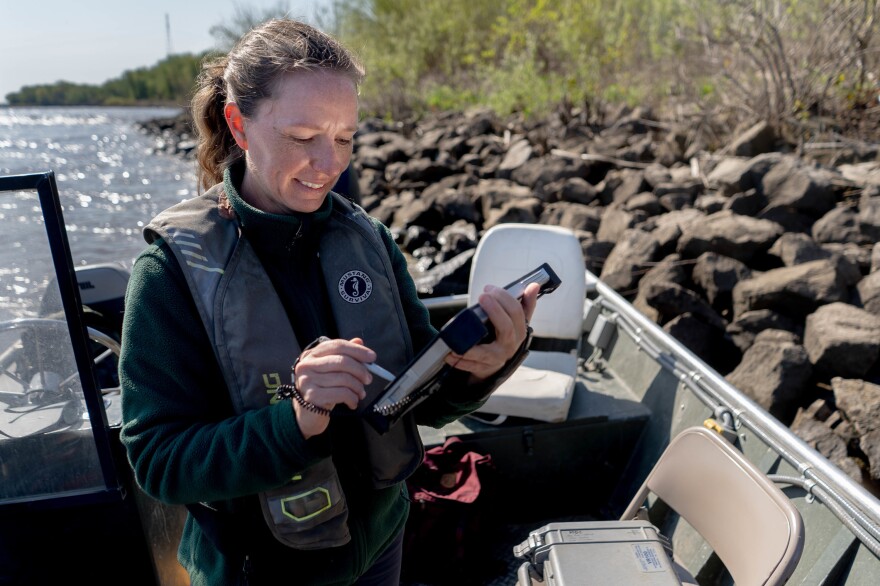Sarah Peper was getting ready for church last month when she got an unexpected phone call from a colleague, alerting her of a rare event: lake sturgeon were spawning along the banks of the Mississippi River near St. Louis.
"I dropped what I was doing and got over there as fast as I could," said Peper, a fisheries biologist for the Missouri Department of Conservation.
Just a few hundred feet from the towering Melvin Locks and Price Dam in West Alton, five endangered lake sturgeon congregated in the shallows, thrashing their tails against the current and releasing peppercorn-sized eggs.
Peper and her colleagues have studied the species for years, but it was the first time they had seen it reproduce in the wild.
"We had a little sturgeon spawning party on the shoreline; we were all just so excited," she said.

Lake sturgeon are ancient creatures that evolved millions of years ago while dinosaurs still walked the Earth. The species was once common in rivers and lakes from Minnesota to Louisiana, but in the past century, overfishing and habitat destruction have driven it to near-extinction. Missouri scientists are now tracking the river giants in the Mississippi to understand where they reproduce and identify critical habitats to protect.
One of the largest freshwater fish in North America, lake sturgeon can weigh more than 300 pounds and reach lengths of nearly eight feet — about a foot longer than a king-size bed. Nicknamed "rubber nose," the lake sturgeon has a shovel-shaped snout and long whisker-like organs near its mouth that it uses to hunt snails, crayfish and other small prey.
Populations of lake sturgeon have plummeted in recent decades, prompting nine states to list the species as endangered, including Missouri, Illinois and Iowa. A federal court last year ordered the U.S. Fish and Wildlife Service to determine whether lake sturgeon should also be protected under the federal Endangered Species Act by 2024.
The lake sturgeon is a powerful swimmer that can travel hundreds of miles through rivers and tributaries, but man-made dams have split up its habitat and prevented it from reaching spawning sites.
"By the early 1900s, their numbers were already getting low because of overharvest, but then the changes we made to the river to improve navigation really destroyed a lot of habitat," Peper said. "When they get a one-two punch like that, it's going to be really difficult for them to recover without some help."

Peper is part of a team of scientists studying where lake sturgeon travel before and after they reproduce — essential information for protecting the species.
Before spawning season, the group captured about a dozen adult lake sturgeon in the Mississippi River this spring and carefully implanted radio transmitters under the silvery skin of their bellies, adding to the hundreds of other lake sturgeon that researchers have tagged in previous years.
On a blustery April morning, state wildlife biologists and the U.S. Army Corps of Engineers climbed into a flat-bottomed speed boat and chugged through the Mississippi River near West Alton, trailing a special microphone in the water to listen for tagged sturgeon.
Just a few minutes later, the radio receiver sputtered to life as a tagged sturgeon passed under the boat. This fish, individual 22462, was tagged three years ago in Keokuk, Iowa.
Some tagged fish have traveled up to 600 miles in just six months, including one sturgeon that swam to Iowa and Ohio before returning to Missouri.
A separate receiver secured to an underwater concrete anchor logs any tagged fish that swim by. In the past month, the receiver has logged 25 tagged fish, including 18 lake sturgeon.

The rocky shore of the Mississippi near the Melvin Locks and Price Dam is the only known spawning site for lake sturgeon in Missouri. By tracking the movements of individual sturgeon during reproduction, the team hopes to pinpoint habitats to protect, Army Corps wildlife biologist Ryan Swearingin said.
"Hopefully, when we have the right conditions, we can help keep this area as hospitable as we can during this prime spawning period," Swearingin said.
Because sturgeon prefer specific water temperatures and speeds during spawning, he said, the Army Corps has been considering whether to open the gates of the dam just enough to create the "sweet spot" of water velocities for sturgeon spawning.
"We're trying to utilize the dam structure to give us some sort of benefits," Swearingin said. "There's a whole lot of dams upstream, so there may be potential where we could do similar management there as well."

For Peper, the project is part of a much larger effort to bring lake sturgeon back from the edge of extinction. The species has survived cataclysmic events over 150 million years, she said, but unless we take swift action, it is likely to disappear forever.
"Think of everything that's happened over those 150 million years; there was the asteroid that killed the dinosaurs, continents crashing into each other and pulling apart, volcanoes and earthquakes," she said. "These fish survived all of that. But they can't survive us unless we do something about it."
Copyright 2023 NPR. To see more, visit https://www.npr.org.


